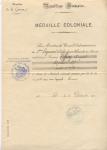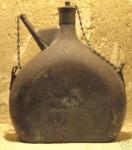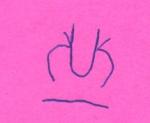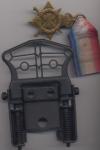-
Posts
29,251 -
Joined
-
Last visited
-
Days Won
84
Content Type
Profiles
Forums
Blogs
Gallery
Events
Store
Everything posted by Chris Boonzaier
-

RK KVK
Chris Boonzaier replied to MasterBo's topic in Germany: Third Reich: State, Civil, NSDAP Awards & Decorations
Is there not a good chance that this is one of the docs stolen from the German Archives and sold in the US? There were some stolen Skorzeny docs posted at WAF sometime ago that were stolen pieces, of the same type as this. Best Chris -
-

Peruvian Cross of Military Merit
Chris Boonzaier replied to RedMaestro's topic in Rest of the World: Militaria & History
Nice find!!! I did not find anything in my trip to peru, just some rusted pistols for sale. The Peruvians managed to souvenier my alarm clock, little maglite, pipe and tobacco and a cheap camera.... ;-) Best Chris -

Iron Division Medal Group
Chris Boonzaier replied to dante's topic in Germany: Weimar Republic & Deutsche Freikorps
Old age ? :-) Dont waoory, it will creep up on me as well some day.... :') -

Saxon Cavalry Sabre
Chris Boonzaier replied to Rod's topic in Germany: Third Reich: Uniforms, Headwear, Insignia & Equipment
I think cavalry officers invested good money in the swords they carried. This one is fancy, but hey.... if you have the loot to spend... I know nothing about German swords, but I would assume he carried it on parade, and when the war broke out, took it into the field. Few swords have period nicks in the blades.... mostly probably fom kids playing with them after the war.... I knicked a few blades as a kid.... -

EK 1914 Why so few EK doc collectors?
Chris Boonzaier replied to Chris Boonzaier's topic in Germany: All Eras: The Iron Cross
Hi, A rough section that I am working on for kaiserscross.com The listening service, "Ahrendstationen", were formed towards the end of 1915, but it was only in January 1917 that they became independant units. In Febuary 1917 there were 22 Arendt-Abteilungen (1J4). In March 1918 they were restructured into 292 Arendt-Stationen. Of these, one was attached to each division (1J5) leaving a number free as a reserve. The staffs of the now defunkt Abteilungen were reasigned to the Akonach and Grukonach to process the information from the messages heard by the stations. Until 1916 there was a carefree exchange of conversation on the field telephone lines. There were few apparant dangers and no concievable negative effects. At some point in 1916 the Germans began to suspect that their communications were being overheard. This suspicion was confirmed then special communications equipment was discioverd in a captured enemy trench. The fact that the enemy could branch themselves directly onto a telephone line was not the issue as the lines ran behind the German lines, rather the enemy was using the electrical current in the earth to listen in. A field telephone operated in an electrical circuit, the message only being transmitted when the current went from the sender to the reciever and back again. This required 2 cables between telephones. An alternate system had been developed to save the confusion that would be caused by having double the amount of cables being strung between positions. The second wire, instead of being connected between the two telephones was connected between the telephone and a steel peg or bayonet, which in turn was stuck into the damp earth, in this way the current would be carried by the earth from one telephone to the other. The catch was, the current did not travel directly from one bayonet to the other, but radiated in all directions. If one was to put another cable into the ground, a "searcher cable", it was possible to pick up these currents, usually to weak to be of any use. With a system of valves and special light bulbs the enemy had suceeded in increasing this current to a point where he could listen in on the telephone conversaton of the German signallers. The Germans immediatly tried to implement counter measures, includining running an "earth wire" with a length of 4-500 meters behind their line. This did not seem to have any effect, so they were forced to do away with the earthing system and run double lines between telephones. It was soon discovered that only telephone lines in perfect condition were secure. Any slight damage to the isolating cover would mean the wire would give off current and this in turn would radiate to enemy litening posts. The German signallers did not take long in creating their own listening stations, named Ahrendtstationen after their founder. These rapidly surpassed the technology and efficiency of the enemy stations. Signalers would often sneak across nomans land and earth their searcher cables directly in front of the enemy positions, or alternately attach them to the enemy barbed wire, which acted as a superb conductor. The results were extremely satisfying to the German high command. It did not take long for the enemy to realise that the Germans now also had listening posts. The counter measures were limited, as on the German side, to implementing a double wire system. This could not prevent the enemy listening in, but did limit the amount of traffic he could listen to. Both sides imposed strict control on telephone conversations, including the content and frequency. Lines not of tactical necessity were removed and front line units were limited to only the bare minimum of calls, once again limited to those of tactical neccesity. The Arendt-Stationen, in addition to their task of listening in on enemy conversations also listened for enemy tunnelers and miners as well as being responsible for listening in on German conversations. All conversations, both enemy and friendly, were recorded and sent to the rear to be controlled. This allowed the staff to sanction those who had breached the rules related to telephone security and access what information may have been intercepted by enemy listeners. -
OK, thought it was strange not to find it anywhere. Thnaks Chris
-
Just got these... of course, the first thing I did was visit Hendriks site... could not find the Atlantique bar though
-
I think even the article that started this all is very suspect in the first place. A also think that we are underestimating the difficulty of the manufacturing of crosses... especially making the dies, assembling them. In Germany they did not get guys off the street, push then into Steinhauer and Luck and say "Assemble these"
-
-
Hi, but very different fron the 2 necked WW1 or the one necked WW2. It cannot be post WW2. The neck is also very narrow indeed, a regular cork closes it which makes it narrower than the regular bidons. Best Chris
-

EK 1914 The Iron Cross....
Chris Boonzaier replied to Chris Boonzaier's topic in Germany: All Eras: The Iron Cross
There are many, many EK related items that are available at niiiiice prices. Postcards, Pics etc. etc. etc. At one point I decided that for me interesting pieces were more important than spectacular pieces. I was bored with sitting there doing a Golem with my KC' s stroking them saying "My precious.... my precious..." and calculated what I could spend the money one if I flogged them 8and panzer wrappers etc. etc. etc.) especially so when you are NOT a multi millionaire and EUR5000 tied up in a KC means you are a bit cash strapped when it comes to buying other goodies. I tossed them all and with the lolly started buying ... EK2 documents.... simple, cheap, overlooked EK2 docs...... the occasional EK1 document etc. etc. To be quite honest... take a look at this... http://www.kaiserscross.com/40029/41427.html And the links built into it. I think the group cost EUR80, it was cheap for what it is. I managed to research this more than my KC which belonged to an oakleaves and gold CCbt clasp winner. For me interests (researching the men and their actions) it allowed me to spend more happy hours than the KC (excluding the time sitting around going "My Precious") -

EK 1914 Various kinds of non combat EKs
Chris Boonzaier replied to Chris Boonzaier's topic in Germany: All Eras: The Iron Cross
Hi, So far all have been govt or military officials with a scattering of "Real" civilians, Doctors etc. I have not seen a serving military/soldiers with a white ribbon... I guess that is where the Black ribboned for service in the Heimat comes in.... So scarce because the military had other kinds of awards to reward them and the military seems to have had more against issuing EKs for Homeland service than the State/civilain bodies who could authorise the white ribboned one. Best Chris -

EK 1914 Various kinds of non combat EKs
Chris Boonzaier replied to Chris Boonzaier's topic in Germany: All Eras: The Iron Cross
Hi, nope, a 100% civilian admin type. Herrn Civilkommisar Dr. Von Bayer-Ehrenberg beim Kaiserl. Kreis-Chef, Verviers. He was a civilian admin official..... I once saw the rest of his group and all civilian stuff. I cannot remember why, but I did not manage to get the rest. -

EK 1914 Various kinds of non combat EKs
Chris Boonzaier replied to Chris Boonzaier's topic in Germany: All Eras: The Iron Cross
Hi, nope, a 100% civilian admin type. Herrn Civilkommisar Dr. Von Bayer-Ehrenberg beim Kaiserl. Kreis-Chef, Verviers. He was a civilian admin official..... I once saw the rest of his group and all civilian stuff. I cannot remember why, but I did not manage to get the rest. -

EK 1914 Certificate help EK2 please
Chris Boonzaier replied to andy's topic in Germany: All Eras: The Iron Cross
Maybe not, maybe not.... I would guess that they simply pushed the job of Kriegsstamrollen over to the war losses dept. There is a stamp on the doc up there that says responsible for Stamrollen. as i think there were just one copy of these I think they were to take over that job as well. I have some documents somewhere that shows all the vetran affairs/POW etc departments laying off personnel and restructuring around this time. I think by then most of their work was done and why have 3 departments when one would do. I bet if this doc had been issued 6 months later the dept would have had a completely other name. -

EK 1914 Various kinds of non combat EKs
Chris Boonzaier replied to Chris Boonzaier's topic in Germany: All Eras: The Iron Cross
See post 22, ulstermans scan..... This is the first thing that confirms what I had suspected all along.... "White Ribbon for DAHEIM services" -

EK 1914 Various kinds of non combat EKs
Chris Boonzaier replied to Chris Boonzaier's topic in Germany: All Eras: The Iron Cross
No no mon ami.... have you ever seen a white cross to a civilian serving OUTSIDE of Germany? I have a cross to a civilian commisar, many , many, many many miles from the front... usual old black ribbon affair. Serving at Verviers in the city administration. Ithink what we had discussed before must be true... white ribbon for service ON THE HOMEFRONT, black ribbon for service outside the Reich (I would guess anywhere over the border, whether it be occupied areas or in the Etappe of an army, no matter how far from the firing) -
Anyone have any ideas about this 1) Bought from France. 2) A kind of zinked tin. 3) Made in two halves welded together 4) Stamped "Deprouve Plombiers"
-

EK 1914 Various kinds of non combat EKs
Chris Boonzaier replied to Chris Boonzaier's topic in Germany: All Eras: The Iron Cross
Hi, bare in mind... 14-18 white ribboned :-) -
-
This is rather a large one. Stanped with what looks like 1005-12-136-6241 with a date 4-70 Anyidea which country and weapon?









